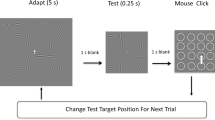Abstract
The contrast threshold elevation effect has been measured for one dimensional (grating) and for two dimensional (spot) stimulus patterns. It has been shown previously (Burton and Ruddock, 1978) that such stimuli elicit, respectively, non-length-selective and length-selective adaptation effects. It is established that, unlike the frequency shift effect, the contrast threshold elevation effect is sensitive to the width of the light but not to that of the dark elements of the stimulus patterns. Adaptation to spot patterns elicits a significant threshold elevation for detection of both spot and grating test stimuli, but only under monoptic viewing conditions. The experimental findings are summarized in a block-diagram and it is shown that adaptation to grating patterns is successfully described by the spatial frequency response data given by Maudarbocus and Ruddock (1973).
Similar content being viewed by others
References
Blakemore, C., Campbell, F.W.: On the existence of neurones in the human visual system selectively sensitive to the orientation and size of retinal images. J. Physiol. (Lond.) 203, 237–260 (1969)
Blakemore, C., Sutton, P.: Size adaptation: a new after effect. Science 166, 245–247 (1969)
Blakemore, C., Nachmias, J., Sutton, P.: The perceived spatial frequency shift: evidence for frequency-selective neurones in the human brain. J. Physiol. (Lond.) 210, 727–750 (1970)
Burton, G.J.: Factors influencing the detection of spatially structured stimuli by the human visual system. PhD Thesis, University of London (1974)
Burton, G.J., Naghshineh, S., Ruddock, K.H.: Processing by the human visual system of the light and dark contrast components of the retinal image. Biol. Cybernetics 27, 189–197 (1977)
Burton, G.J., Ruddock, K.H.: Visual adaptation to patterns containing two-dimensional spatial structure. Vision Res. 18, 93–99 (1978)
De Valois, K.K.: Independence of black and white: phase specific adaptation. Vision Res. 17, 209–215 (1977)
Dow, B.M., Gouras, P.: Color specificity of single units in rhesus monkey foveal striate cortex. J. Neurophysiol. 36, 79–100 (1973)
Gilinsky, A.S.: Orientation-specific after effects of patterns of adapting light on visual acuity. J. Opt. Soc. Amer. 58, 13–18 (1968)
Gouras, P.: Opponent-colour cells in different layers of foveal striate cortex. J. Physiol. (Lond.) 238, 583–602 (1974)
Hubel, D.H., Wiesel, T.N.: Receptive fields, binocular interaction and functional architecture in the cat's striate cortex. J. Physiol. (Lond.) 160, 106–154 (1962)
Hubel, D.H., Wiesel, T.N.: Receptive fields and functional architecture of monkey striate cortex. J. Physiol. (Lond.) 195, 215–243 (1968)
Levick, W.R.: Form and function of cat retinal ganglion cells. Nature 254, 659–662 (1975)
Maffei, L., Fiorentini, A., Bisti, S.: Neural correlate of perceptual adaptation to gratings Science 182, 1036–1038 (1973)
Marr, D.: Early processing of visual information. Phil. Trans. Roy. Soc. Lond. B. 275, 483–524 (1976)
Maudarbocus, A.Y., Ruddock, K.H.: Non-linearity of visual signals in relation to shape-sensitive adaptation responses. Vision Res. 13, 1713–1737 (1973)
Maudarbocus, A.Y., Ruddock, K.H.: Comments on “Adaptation to pairs of coloured gratings: inhibition between colour specific spatial detectors in the human visual system” by C. R. Sharpe. Vision Res. 14, 1485–1487 (1974)
May, J.G.: Chromatic adaptation of orientation and size-specific visual processing in man. Vision Res. 12, 1509–1517 (1972)
Nakayama, K., Roberts, D.J.: Line-length detectors in the human visual system: evidence from selective adaptation. Vision Res. 12, 1709–1713 (1972)
Pantle, A.J., Sekuler, R.W.: Size detection mechanisms in human vision. Science 162, 1146–1148 (1968)
Ruddock, K.H., Wigley, E.: Inhibitory binocular interaction in human vision and a possible mechanism subserving stereoscopic fusion. Nature 260, 604–606 (1976)
Schiller, P.H., Finlay, B.L., Volman, S.F.: Quantitative studies of single cell properties in monkey striate cortex. I. Spatiotemporal organisation of receptive fields. J. Neurophysiol. 39, 1288–1319 (1976)
Wiesel, T.N., Hubel, D.H.: Spatial and chromatic interactions in the lateral geniculate body of the rhesus monkey. J. Neurophysiol. 29, 1115–1156 (1966)
Author information
Authors and Affiliations
Rights and permissions
About this article
Cite this article
Naghshineh, S., Ruddock, K.H. Properties of length-selective and non-length-selective adaptation mechanisms in human vision. Biol. Cybernetics 31, 37–47 (1978). https://doi.org/10.1007/BF00337369
Received:
Issue Date:
DOI: https://doi.org/10.1007/BF00337369




